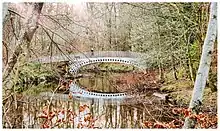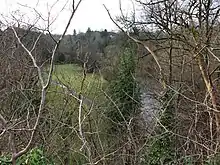Linn Park, Glasgow
Linn Park is an 82-hectare (200-acre)[1] park in Glasgow, Scotland, surrounded by the suburbs of Cathcart, Muirend, Simshill, and Castlemilk, also bordering Netherlee in East Renfrewshire. It is Glasgow's third largest park, after Pollok Country Park and Dams to Darnley Country Park, although Dams to Darnley is half in East Renfrewshire. Both Linn and Pollok parks have the White Cart Water flowing through them. Some areas in the park are unsuitable for prams and the infirm.
| Linn Park | |
|---|---|
.jpg.webp) The "Halfpenny Bridge" over the White Cart Water
 The "Halfpenny Bridge" over the White Cart River | |
| Type | Public park |
| Location | Glasgow, Scotland |
| OS grid | NS5847059131 |
| Coordinates | 55°48′17″N 4°15′30″W |
| Area | 82 hectares (200 acres) |
| Operated by | Glasgow City Council |
History and features
The park was acquired by Glasgow Corporation in 1919 and incorporated within the city boundaries in 1938.[2] It was originally part of the lands of Hagtonhill and several others owned by the Maxwell family, who were extensive local landowners based at Pollok House.[3] The park is managed by Glasgow City Council and there is an active Friends of Linn Park group.[4]
The remains of Cathcart Castle are situated at the northern end of the park. The castle was built by the first Lord Cathcart around 1450 and added to the park in 1927. It was demolished in 1980 after lying derelict for a long period.[5]
The park contains a large mansion, Linn House, which was originally built c. 1811[6] for Rev. James Hall, who a short time later became bankrupt resulting in the house and estate being put up for auction on behalf of the creditors. James Hall's wife, Mary Maxwell, separately owned adjacent land at Bogton which was the subject of a legal action by the creditors against her, which was determined at the Court of Session in January 1814.[7] The mansion and surrounding estate was sold again in 1820, by which time the familiar cast iron "Ha'penny Bridge" (now a Category B listed structure) was in place.[8][9]

A new mansion house was then constructed in the 1820s and extended in the 1850s, the architect being Charles Wilson.[10][11][12] The name "Linn" refers to the waterfall on the river[3] and old maps show that the title pre-dates the development of the mansion house, which was converted to four private homes in 2007 after lying derelict for some time.[13][14]

The park offers woodland and river walks. There is also an equestrian centre, an orienteering course, an 18-hole public golf course[15] (bordering the suburb of Castlemilk but accessed from Simshill) - this was once Cathcart Castle Golf Club, this was set out in the 1890s before the Glasgow Corporation purchased the land and the club moved out to their current site near Clarkston in East Renfrewshire in 1924.[16] There are also a couple of children's play areas, one of which is on the opposite bank of the White Cart from the majority of the park's land, directly adjacent to Cathcart Cemetery.[17] A small area of the park has been made inaccessible by a fence cordoning off an area containing a potentially dangerous landslip.[18]
On the southern edge of the park are Linn Crematorium[19][20] and Linn Cemetery[21] (accessed from Castlemilk, where there is also a small industrial estate named after the park).
In late 2021, Glasgow City Council closed one of the main entrances and paths into the park due to falling rocks. The path, at Snuff Mill Bridge, is the main entrance to the park from Cathcart. The council has not provided a date for reopening.
References
- "Linn Park and Local Nature Reserve". www.glasgow.gov.uk. Glasgow City Council. Retrieved 29 May 2022.
- "Linn Park (West of Scotland Archaeology Service, 1946)". The Glasgow Story. Retrieved 13 February 2018.
- Mill Dam, Cathcart (Glasgow School of Art Archives, 1890s), The Glasgow Story
- Friends of Linn Park
- Marshall, Jean. Cathcart and Environs: A Pictorial Reminiscence. Glasgow District Libraries. ISBN 0-906169-26-7.
- Sale Notice dated 24 October 1811 refers to "new house".
- Stewart v Maxwell, 11 January 1814, Fac. Coll.
- Sale Notice dated 16 March 1820 refers to "elegant Cast Iron bridge".
- Glasgow, Netherlee, Linn Park Bridge, Canmore
- The Lynn, Old Country Houses of the Old Glasgow Gentry (1878)
- Glasgow, 20 Linn Park, Mansion House, Canmore
- The Lynn (Glasgow University Library, Special Collections, Dougan Collection, 1870), The Glasgow Story
- Linn Park Mansion, Urban Realm, 2007
- Luxury flat in secluded Victorian mansion up for sale in heart of Glasgow park, Glasgow Live, 2 August 2019
- Glasgow, Simshill Road, Linn Park Golf Course, Canmore
- History of the club, Cathcart Castle Golf Club
- Linn Park Adventure Playground, Glasgow Life
- "See the photograph".
- Glasgow, Lainshaw Drive, The Linn Crematorium, Canmore
- (Linn Crematorium (Mitchell Library, Glasgow Collection (2004), The Glasgow Story
- Linn Cemetery (Mitchell Library, Glasgow Collection, 2004), The Glasgow Story
External links
- Linn Park (guide and map) – Glasgow City Council
- White Cart Walkway & Linn Park (illustrated guide)
- Linn Park et alia loca (walkers' guide to flora and fauna)
.jpg.webp)